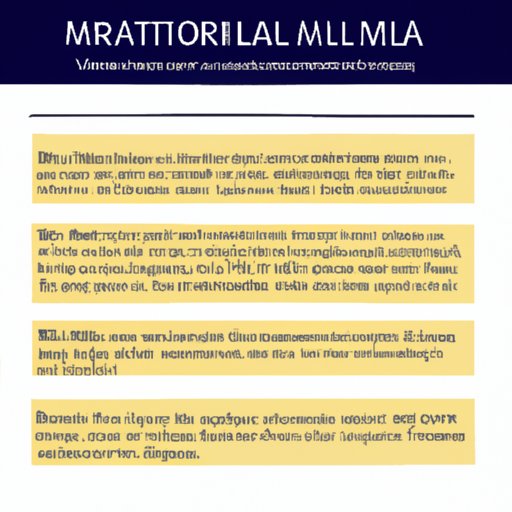I. Introduction
MLA format is a commonly used style guide for academic writing, ranging from essays to research papers. The Modern Language Association established this format, which offers consistency and structure to writing across different fields of study.
This article aims to provide a step-by-step guide on how to do MLA format. Whether you’re a student or a writer, understanding how to format your work correctly can ensure that your papers are polished and professional.
II. Step-by-Step Guide
Formatting an essay in MLA style can seem overwhelming at first, but it’s important to take it one step at a time. Here’s a quick guide to help you format your paper:
1. Title Page
In MLA format, the title page is not necessary. However, if requested, follow the guidelines below:
- The title should be centered on the page and written in title case (all major words capitalized).
- Include your name and the date beneath the title, also centered on the page.
2. Header and Margins
- Your paper should have 1-inch margins on all sides.
- The header should be placed in the top right corner of every page and include your last name and the page number. Use the “insert” function in your word processor to create a header that is automatically applied to every page.
- Do not include a title page header, only the header with your last name and page number.
3. Essay Components
The body of your essay should include:
- An introduction that includes your thesis statement and contextualizes your topic.
- Body paragraphs that support your thesis and transition smoothly.
- A conclusion that restates your thesis and provides a sense of closure.
4. In-Text Citations
Whenever you incorporate information from a source, whether that be a quote or paraphrase, you must include an in-text citation that points your reader to the works cited page. In-text citations can take two forms:
- With the author’s name within your sentence
- With the author’s name in parentheses
The format for in-text citations using the author’s name within your sentence is:
Last name of the author(s) (page number)
The format for an in-text citation with the author’s name in parentheses is:
(Last name of the author(s) page number)
5. Works Cited Page
Your works cited page should begin on a new page and include all of the sources you used in your work, including any direct quotes or paraphrased information. Entries should be listed in alphabetical order by the author’s last name. Here is the general format for a works cited page:
- Author’s Last name, First name. “Title of Source.” Title of Container, Other Contributors, Version, Number, Publisher, Publication date, Location.
III. Common Mistakes
When formatting an essay in MLA style, it is easy to make mistakes. Here are some common errors that students should avoid:
- Incorrectly formatted in-text citations
- Missing information in the works cited page
- Inconsistent formatting throughout the paper
- Mistakes in title capitalization
The best way to avoid these errors is to double-check your formatting and use a formatting guide or tool when necessary.
IV. Example Essay
Here is an example essay formatted in MLA style:
Example Essay:
Smith, John. “The Importance of MLA Format.” Writing Today, vol. 2, no. 1, 2022, pp. 10-15.
In this essay, I will discuss the importance of MLA format in academic writing. Proper formatting is essential to a professional and polished essay, and MLA is a common format used by many institutions.
The introduction of an essay in MLA style should begin with contextualizing the topic of the paper, leading to a clear thesis statement. The thesis of this paper is that MLA format is an essential tool for academic success, providing structure and clarity to your work.
The body paragraphs should then support the thesis statement with relevant evidence and analysis.
One important aspect of MLA format is including in-text citations for all sources used in your research. These citations should be formatted correctly to ensure that readers can easily find the corresponding source in the works cited page.
The conclusion of the essay should restate the thesis and provide a sense of closure, summarizing the main points and reminding the reader why your argument is important.
V. Video Tutorial
For visual learners, a video tutorial can be a great resource. Check out this video for an in-depth look at how to format an essay in MLA style:
VI. Quick Reference Guide
For an easy-to-follow guide to MLA formatting essentials, use this quick reference:
- 1-inch margins on all sides
- Header with your last name and page number in the top right corner of every page
- Double-spaced throughout the entire paper
- Title centered on the page, written in title case
- In-text citations should include the author’s last name and page number
- Works Cited page should begin on a new page with entries listed in alphabetical order by author’s last name
VII. Visual Guide
A visual guide can also be helpful in understanding MLA formatting. Check out the infographic below for a breakdown of how to format an essay in MLA style:

VIII. Conclusion
With this step-by-step guide, you should now have a better understanding of how to format an essay in MLA style. Remember to double-check your work and use additional resources when needed. One great resource to utilize is an MLA formatting tool, such as Purdue Owl or citation generators, to ensure that your formatting is always correct.
Formatting in MLA style can seem daunting at first, but once you understand the guidelines and formatting rules, you’ll be on your way to professional-level essays in no time.
